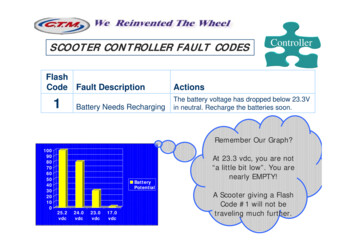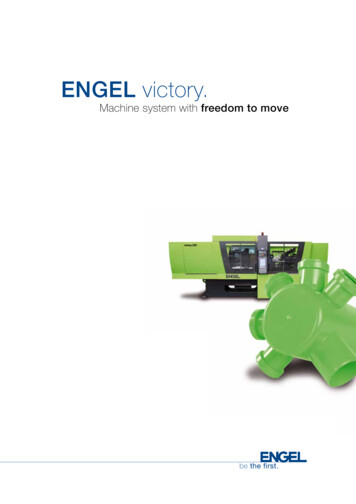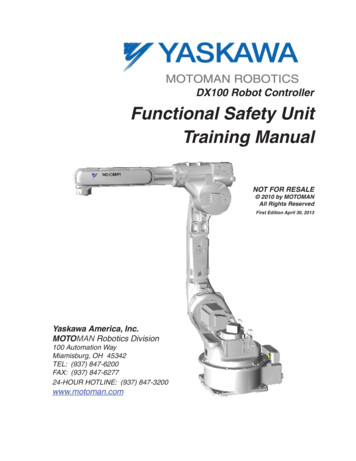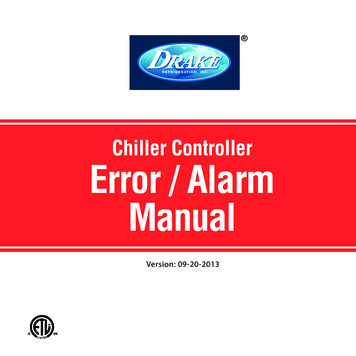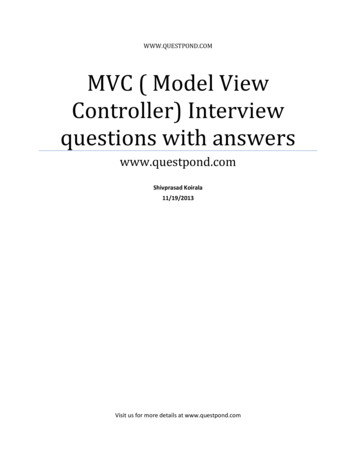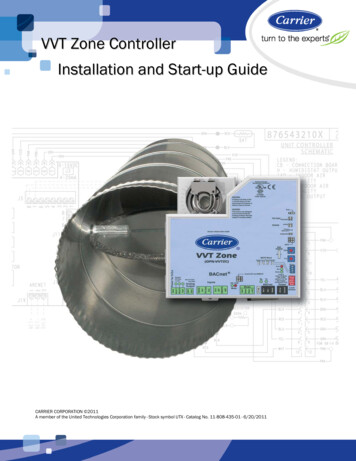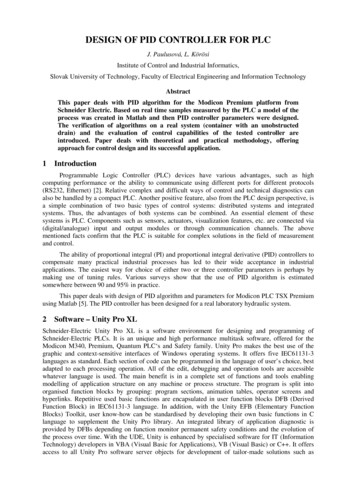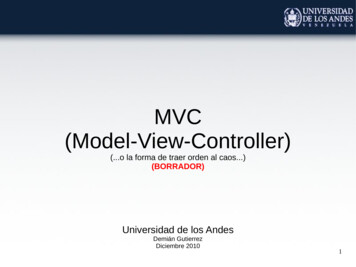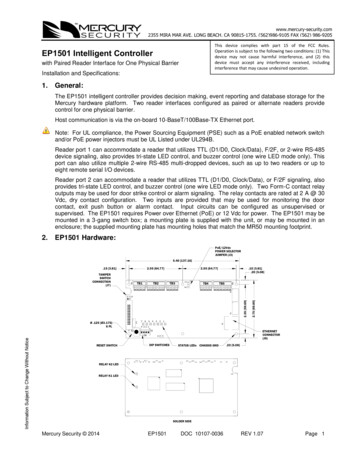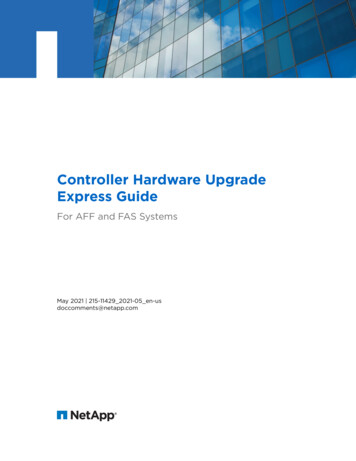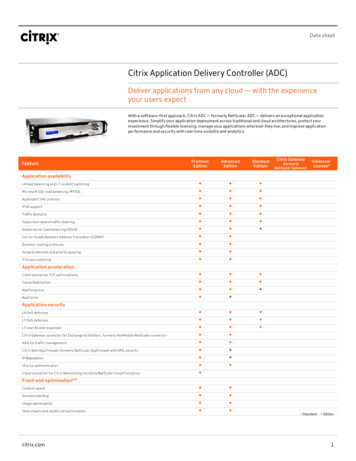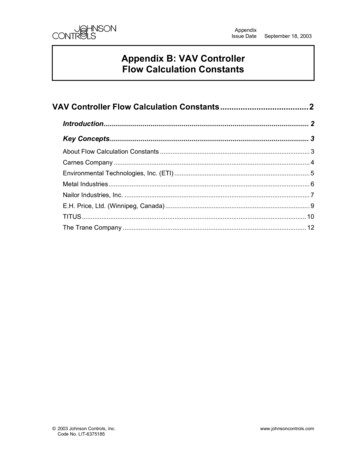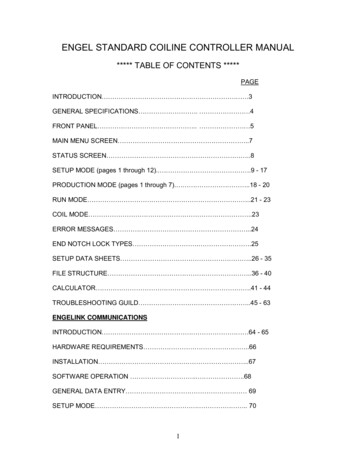
Transcription
ENGEL STANDARD COILINE CONTROLLER MANUAL***** TABLE OF CONTENTS *****PAGEINTRODUCTION 3GENERAL SPECIFICATIONS . 4FRONT PANEL . 5MAIN MENU SCREEN .7STATUS SCREEN .8SETUP MODE (pages 1 through 12). .9 - 17PRODUCTION MODE (pages 1 through 7). .18 - 20RUN MODE .21 - 23COIL MODE .23ERROR MESSAGES .24END NOTCH LOCK TYPES . .25SETUP DATA SHEETS .26 - 35FILE STRUCTURE .36 - 40CALCULATOR .41 - 44TROUBLESHOOTING GUILD .45 - 63ENGELINK COMMUNICATIONSINTRODUCTION 64 - 65HARDWARE REQUIREMENTS .66INSTALLATION .67SOFTWARE OPERATION . .68GENERAL DATA ENTRY 69SETUP MODE . . 701
BATCH MODE �–––––––––––––– 71 – 76DATA PRINTOUT / CALCULATOR ––––––––––––––– 77 - 78TRANSMISSION ��–––––– 79 - 83FILE STRUCTURE �––––––––––– 84 - 86LABEL DATA �–––––––––––––––– 87 - 88COMPUMOTOR TUNING �–––––– 89 - 90COMMUNICATION TRANSMISSION –––––––––––––– 91HOLE PUNCH INFORMATION �–– 92 - 94COM 1 / COM 2 CABLING �––––– 95BONDING ��– 96 - 100GENERAL OPERATING INFORMATIONDEEP CALIBRATION OF HLB BRAKE ––––––––––––– 101PROCEDURE TO MAKE NEW OPERATING DISK–––– 102REDUCE RAZOR SLICES FROM SHEAR –––––––––– 103QUICK COILINE CHECK OUT �–––104LEVELER PINCH ROLL ADJUSTMENT––––––––––––– 105REMOTE START/STOP SYSTEM � 106 - 107ADJUSTING BRAKE STOP ARM RACK –––––––––––– 108SETUP HARD DISK DRIVE �––––– 109 - 110LOADING COILS �–––––––––––––– 111UNCOILING METAL �–––––––––––– 112S & DRIVE DUCT SETUP �––––––– 113BLANKING METAL �––––––––––––– 114LINER � 115CDA �–– 116
T.D.F. DUCT SETUP �–––––––––––– 117ADJUSTING BRAKE CLAMP RACK � 118DUCT-MATE DUCT �––––––––––––– 119PLC & PC History �––––––––––––––– 120 – 124Upgrade Programs �–––––––––––––– 125Directional Valves �––––––––––––––– 126CEF Sensor Specs �–––––––––––––– 127
INTRODUCTIONThe Engelrun controller is a marriage of the E.C.-11 and E.C.-21 systems and isa computer system specially designed to control sheet metal processingmachines. These machines convert coils of sheet metal material into cut parts,which may include: vee notches, end notches, and hole punches. Ductwork forthe heating, air conditioning, and ventilation industry is the completely assembledend product of these parts.The controllers boast a user-friendly operator interface. This type of softwaredesign allows easy data entry; the operator has only to enter a minimal amountof information. In addition, there is capability of programming one hundredseparate jobs. The software can track a total of fifteen different coils at once.With a coil number assigned to a job, the software will track the total linear feetused on a coil. An ASCII report file, maintained continuously, provides productionstatistics such as material square footage consumed and required productiontime. This is just a sampling of some the controllers capabilities.The integrated Engelrun system controls a two-speed line. This type of line slowsthe advancing material, then stops before each operation. Operating thecontroller itself is straightforward. The controller uses an incremental shaft angleencoder to sense material movement. This encoder generates a pulse train thatis equal to an exact amount of material movement. The controller then counts thepulses and activates the appropriate machine functions when thepreprogrammed movement has occurred. As mentioned earlier, two-speed lineoperation allows the machine to slow the material before reaching the point ofoperation. This concept contributes to the production of very accurate parts.The controller accepts data input via a keyboard located on the front panel. Thecontrollers display device is a high resolution VGA monitor. This monitor allowsthe user to view an entire page of setup, job, coil, or status information at onetime. Data is input, or changed, by observing the screen and using theappropriate keys located on the front panel.3
GENERAL SPECIFICATIONSThe following is a general specification for the controller. A NEMA 12 consolehouses the control system. The console size varies depending on the quantity ofpurchased options, in general, the E.C.-11 used a 24-inch console, and the E.C.21 incorporates a 48-inch console.Resolution:.010 inch with a l2 inch wheel Accuracyoutput turned on within 25 microsecondsof operation excluding errors in machinetolerance.Maximum Counting Speed:200 feet per minuteMaximum Part Length:9999.99 inchesMaximum job Quantity:9999Number of Batches:100Pattern Types:5 each - (Blank, Flat, L-duct, U-duct,and Wrapper)Input Power:115 VAC 10%, 50-60 Hz (132vac-109vac)Outputs:Forward, Slow, Reverse, Shear, EndNotch, Vee Notch, Die Select, HolePunch4
FRONT PANEL CONTROLSOn the front panel of the controller console are IO lighted pushbutton switchesand a 101 -key keyboard on the console deck. The operator passes informationto the controller with the switches and keyboard.The functions of the push button switches are as follows:HALTThe HALT key is used to stop the machine from running material in automaticmode. The red lamp indicates that the controller is in the HALT mode.RUNThe RUN key is used to initiate an automatic run of the controller. The greenlamp indicates that the controller is in the RUN mode.REMOTE DATA LINKThe DATA LINK key is used to turn the remote link on or off. The blue lampindicates when the remote data link is on. Office communications on the olderversions can take place during a run condition, destroying existing, running data.See the ENGELINK section of this manual for more information.MANUALSHEARThe MANUAL SHEAR key is used to manually cycle the shear output when theline is in the HALT mode. The yellow lamp indicates when the shear output is“on" in either the HALT or RUN mode.RESETThe RESET push button is used to reset the controller when a job is beingprocessed. First level reset (pressed once for short period of time). Use: Drop outof run mode. Second level reset - referred to as a long or total reset (pressedonce for a long period of time). Screen will display "Down stream data destroyed"Use: Destroy data setups to LOM, Brake, etc.MANUAL VEE NOTCHThe MANUAL VEE NOTCH key is used to manually cycle the vee notch outputwhen the line is in the HALT mode. The yellow lamp indicates when the veenotch output is "on" in either the HALT or RUN mode.MANUAL END NOTCHThe MANUAL END NOTCH key is used to manually cycle the end notch outputwhen the line is in the HALT mode. The yellow lamp indicates when the endnotch output is on" in either in HALT or RUN mode.5
FRONT PANEL CONTROLSMANUAL SLOWOverrides the PLC slow output. This function is not an input to the PLC andoverrides the PLC slow control. This function button can be held 'in' for manualslow overall operation, (i.e. Initial forward automatic threading of first part).METRICChanges the screen display and keyboard inputs from English units to metricunits, pressing the push button again, changes the screen display from metricunits to English units.The following are the descriptions of the functions of the keyboard keys:ADD LINEThe INSERT key is used in the batch mode to insert a new line at the currentcursor position.DEL LINEThe DELETE key is used in the batch mode to delete the line that the cursor iscurrently on. For further information on deleting lines, see the section titled 'RUNMODE.'UP-DOWN ARROWThe UP or DOWN ARROW key is used in all modes of operation to move thecursor up or down to the next data line. The position of the cursor in respect tothe data line is retained.LT-RT ARROWThe LEFT or RIGHT ARROW key is used in all modes of operation to move thecursor left or right. The position of the cursor in respect to the data column isretained.PAGE UP-DNThe PAGE UP or DN key is used in the setup and batch modes to view the nextscreen or page of data. In the setup mode, if the current page is page 3, pressingthe page down key will cause the screen to display page 4. In the batch mode,pressing PAGE DN will cause the screen to show the next page of batch dataunless the cursor is presently on the last page.The opening screen after initializing is the STATUS screen, this will inform theoperator the present status of the system. Press ESCAPE to exit to MAIN menu.(See6
FRONT PANEL CONTROLSFl - EDIT SETUP DATA (See page 1)The Fl key is used to enter the setup mode from the main menu. If the securitykey located on the front panel is not on, data may be reviewed, but may not bechanged.F2 - EDIT PRODUCT DATA (See page 1)The F2 key is used to enter the product mode from the main menu.F3 - INFORMATION (See Page 1)The F3 key is used to view the help screens.F4 - STATUS (See Page 8)The F4 key will display the machine status as controlled by the controller. Someitems and functions on the machine are not controlled by the controller but byexternal circuitry or controls.F5 - QuitThe F5 key will update the production; setup, maintenance, report and coil filesfrom the latest information in the PLC, then will copy those files to the disk drive.F6 - Maintenance (See Page 1)The F6 key will display the present maintenance time count down from variousitems recommended maintenance times.NOTE: An expected COM 2 will display if missing. An expected good setup filewill display if missing.7
STATUS SCREENF7-Shell (See Page 1)The F7 key will cause the system to shell out to a file in DOS to allow operationof third party programs. This feature is not on the standard version, but may berequested.The Status screen will indicate the status of the parameters of thesystem. Though this picture is not in color, the actual screen on thesystem is in color. The items that are not available are in RED anditems available in GREEN.Internal battery is the battery in the PLC.Power supply battery is the battery in the power supply.Last Error will give an indication code of any errors in the PLC portionof the system.Communication channel 1 is required to have office link.Communication channel 2 is required to operate a wrapper brake.Unit of measure is green for English and amber for Metric.NOTE: An expected good setup file will display if missing.8
SETUP MODE SCREEN PAGE 1F1 – Position cursor on page one. No matter which setup page you are on, thisfunction will return to this page.F2 - CALCULATORThe F2 key is used, while in the setup or production screen, to enable the onscreen calculator. The calculator has the capability of exporting a result back tothe main program.F3 - PRINT OUTThe F3 key is used, while in the Setup or production screen, to make a hard copyof the setup or production data.Cycles per Revolution entry is based upon the counts of the encoder. Thisinformation is normally printed on the nameplate of the encoder.Distance per revolution is based on the circumference of the encoder wheel.Correction Factor is a multiplier used by the systems calculation to correct forwear on the encoder wheel.Slowdown distance is the amount of distance used to bring the hydraulic driveto a complete stop.Minimum Movement is the smallest forward movement after a reversemovement to reduce system hysteresis from chains and gears.Shear Actuation Time is the time allotted to perform a complete shear. Thesystem does not track the up or down position of the shear.9
SETUP SCREEN PAGE 1 cont’dPause Time After Shear is the delay used between parts. Blank parts can haveless delay time, while wrapper parts must have more time between parts to givethe brake sufficient time to complete and eject the part.Remote Metal Flow will determine the length or width to be leading or trailingedge. In NORMAL mode, the machine is Z-shaped and the length is theresulting leading edge. In REVERSE mode, the machine is U-shaped and thewidth will be the resulting leading edge.Halt – shear only parts Normally the controller stops the line at the completionof each batch (or job). However, if a NO response is given, there will be no haltbetween batches of blanks.SETUP SCREEN PAGE 2END NOTCH TO SHEAR DISTANCE is the distance from the center of the endnotch die to the center of the shear die (See appendix R).VEE NOTCH TO SHEAR DISTANCE is the distance from the center of the veenotch die to the center of the shear die (See appendix R).END NOTCH ACTUATION TIME is the time required f r the end-notch output tobe on" to complete an end notch operation.10
SETUP SCREEN PAGE 2 cont’dVEE NOTCH ACTUATION TIME The VEE NOTCH ACTUATION TIME is thetime required for the vee-notch output to be "on" to complete a vee notchoperation.HOLE #1 PUNCH TO SHEAR DISTANCE is the distance from the center of the#1 hole punch die to the shear edge of the shear. This distance can bedetermined in the same manner as for the end notch die. The hole punchproduction screen entries will be by- passed (no hole punch available), byentering zero in the hole punch to shear distance.HOLE #2 PUNCH TO SHEAR DISTANCE is the distance from the center of the#2 hole punch die to the shear edge of the shear. This distance can bedetermined in the same manner as for the end notch die. The hole punchproduction screen entries will be by- passed (no hole punch available), byentering zero in the hole punch to shear distance. The #2 punch can be actuatedwith the punch select switch on the far side of the punch frame.HOLE PUN
engel standard coiline controller manual ***** table of contents ***** page �––––––––––3 general specifications–––––––––. ––––––––4 front . ––––––––5 main menu �–––– File Size: 1MBPage Count: 128
